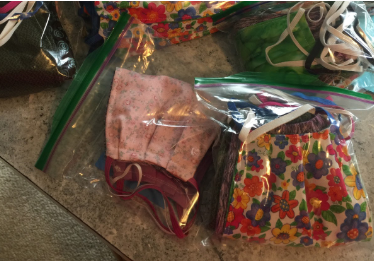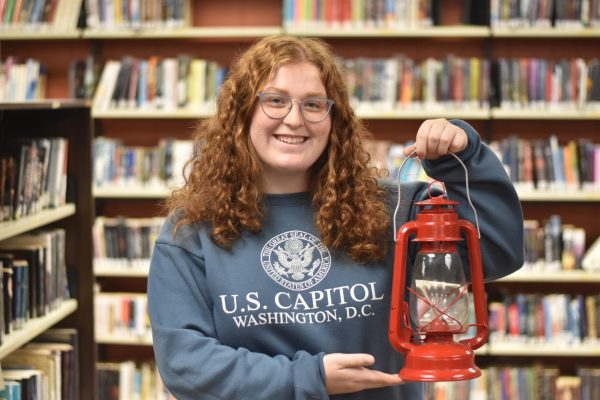Marvelous masks

Once the masks were finished, they were sorted into plastic bags.
There has been a huge swell in face mask usage lately as the COVID-19 virus works its way across the world. Fearful citizens wear them on the few trips taken out of the house. Food workers sport these masks for the safety of their consumers. Health care workers must wear them to protect themselves and their patients. This has caused a severe mask shortage because ordinary citizens are desperately trying to get their hands on a few masks, but healthcare workers also need them to take care of patients. Unfortunately, companies that make these important pieces of protection can’t keep up with high demand. This has caused crafters everywhere to do their part to help with this shortage: cloth mask making. Mrs. Klapperich, a sixth-grade teacher at Cannon Falls Middle School, has recently started making cloth masks in her free time to help nursing homes, post office staff, grocery store workers, or anyone else who is working and in need of a mask.
Klapperich was inspired to take part in this project by her long distance friend from high school who is making cloth masks near Chicago. At first, when Klapperich’s friend advised her to make these masks, Klapperich refused, saying that she didn’t have a sewing machine and hadn’t sewn since her high school home-economics class. Two days later, a giant box showed up on Klapperich’s doorstep and inside was a sewing machine. Her friend, set on getting the social studies teacher to join the movement, had sent her one the moment she heard of Klapperich’s problem. With the lack of sewing equipment no longer standing in her way, Klapperich got her mask pattern and design from a CDC-approved website and began to make the masks. “The pattern was really easy and I could actually read it. Then I started to make them, and it kind of got to be obsessive.” Klapperich expressed.
After hearing of Klapperich’s new pastime, Jeff Sampson, superintendent of schools, asked Klapperich if she would make masks for the staff who were still working at the school. Klapperich agreed and started working. “I got sixty-five of them made for him in thirty-six hours,” she said with a laugh. Between making the masks for Sampson, as well as making them for the nursing homes and assisted living facilities, Klapperich has made over 210 masks in about two weeks. Each mask takes about twenty minutes to make (between cutting the fabric and elastic and sewing the mask together). She makes them not only at night during her free time, but also wakes up early to produce a few more before starting class. However, after making masks for a while, it gets rather boring and repetitive. Klapperich explained that to curb the boredom she listens to music or news on the radio. She is not alone though. A group in her community is also making the masks to distribute. As a whole, they have made about 850 masks.
Klapperich emphasized that donations have been a major help in her impressive production of the face masks. Most of the fabric and supplies were donated by members of the community. “All of it is volunteer and donated supplies, so it wouldn’t happen if the community didn’t chip in and help with the supplies. Those of us making the masks run out of supplies right away. Elastic is really hard to find, so I bought a big spool of elastic, and it had to come from California. The roll I bought was like 200 yards, but I’ll go through that pretty quick.” After the masks are made, she washes them with hot water and bleach as a way to help kill any germs that may be on the masks.
Though there is a drop-off at the grocery store for cloth masks, Klapperich is not able to go. She has two heart conditions, asthma, and has had a spleenectomy, making her immune system very compromised, which makes her susceptible to the COVID-19 virus. Luckily for Klapperich, a friend picks up all of the masks she produces from her doorstep and brings them to the grocery store. While Klapperich is unsure of what happens to the masks once they reach their destination, she guesses that they are washed again with hot water, bleached, and then put to work.
Klapperich stressed that none of this would be possible without donations and help from everyone in the community, especially the teaching staff. “I’m one of those people that can’t leave my home and I want to do something that will help. This is something that will help that won’t put me in danger. In situations like this, it’s great for people to volunteer and do what they can, where they can, when they can.” Klapperich acts as an inspiration for many, showing that no matter your situation or how much you think you can do, every little bit of help is appreciated. Opportunities are out there, even if they aren’t apparent. Who knows, someone may also wake up to find a sewing machine on your doorstep.

Salutations! I am Grace Miller, the editor-in-chief for the Lantern. I am heavily involved in FFA, speech, and my job as a barista, but my true calling...

